ISSN ONLINE(2319-8753)PRINT(2347-6710)
ISSN ONLINE(2319-8753)PRINT(2347-6710)
Virendra Nayak1, Y.P. Banjare2 and M. F. Qureshi3
|
| Related article at Pubmed, Scholar Google |
Visit for more related articles at International Journal of Innovative Research in Science, Engineering and Technology
Catalytic converters are the most effective means of reducing pollutant emissions from internal combustion engines under normal operating conditions. But the future emission requirements cannot be met by three way catalysts (TWC) as they cannot effectively remove hydrocarbon (HC) and carbon monoxide (CO) emissions from the outlet of internal combustion engines in the cold-start phase. Therefore, significant efforts have been put in improving the cold-start behavior of catalytic converters. In the experimental study, to improve cold-start performance of catalytic converter for HC and CO, a burner heated catalyst (BHC) has been tested in a four stroke, spark ignition engine. The modeling of catalytic converter performance of the engine during cold start is a difficult task. It involves complicated heat transfer and processes and chemical reactions at both the catalytic converter and exhaust pipe. In this study, to overcome these difficulties, multi-output adaptive neuro-fuzzy inference system (M-ANFIS) is used for prediction of catalyst temperature, HC emissions and CO emissions. The training data for M-ANFIS is obtained from experimental measurements. In comparison of performance analysis of M-ANFIS the deviation coefficients of standard and heated catalyst temperature, standard and heated catalyst HC emissions, and standard and heated catalyst CO emissions for the test conditions are less than 4.825%, 1.502%, 4.801%, 4.725%, 4.79% and 4.898%, respectively. The statistical coefficient of multiple determinations for the investigated cases is about 0.9981–0.9998. The degree of accuracy is acceptable in predicting the parameters of the system. So, it can be concluded that M-ANFIS provides a feasible method in predicting the system parameters. In this paper we propose a new type of multi output adaptive neuro-fuzzy inference system (M-ANFIS) with several outputs. To proves its performances, the proposed multi output ANFIS is used to make the approximation at the same time of three different functions. Simulation results show that this neuro-fuzzy system can approximate, with the desired precision, these three functions.
Keywords |
| Catalytic converter; Cold start multi-output adaptive neuro-fuzzy inference system (M-ANFIS), training, gradient descent. |
INTRODUCTION |
| Because of the growing number of vehicles running all over the world, the problem of urban air pollution has been gained so much importance (Caraceni et al. 1999). The spark ignition engine exhaust gases contain nitrogen oxides (NOx), CO and organic compounds, which are unburned or partially burned HCs. CO and HC occur because the combustion efficiency is lower than 100% due to incomplete mixing of the gases and the wall quenching effects of the colder cylinder walls. The NOx is formed during the very high temperatures of the combustion process (Heck et al. 2000). Improvements in engine design, microprocessor controlled fuel injection and ignition systems have been substantially reducing the pollutant emissions for two decades in spark ignition engines. However, further reductions in exhaust emissions can be obtained by removing pollutants in the exhaust system. TWC’s that controls the pollutant emissions of HC, CO and NOx are an effective way to reduce exhaust emissions (Kirchner et al. 1997). But the requirements of future emission standards cannot be met by conventional TWC, as they cannot efficiently remove HC and CO from the outlet of internal combustion engines in the cold-start phase (Zhenming et al. 2001). |
| The efficiency of a catalytic converter is very dependent on temperature. Until it reaches light off temperature at which a converter becomes 50% efficient, 50% to 80% of the regulated HC and CO emissions are emitted from the tailpipe. When the engine first starts, both the engine and catalyst are cold. After startup the heat of combustion is transferred from the engine and the exhaust piping begins to heat up. Finally, the temperature is reached within the catalyst that initiates the catalytic reactions. This light-off temperature and the concurrent reaction rate is kinetically controlled; i.e. depends on the chemistry of the catalyst since the transport reactions are fast (Heck et al. 2000). In order to reduce cold-start emissions, special techniques have been developed. These techniques are referred to as fast light-off techniques. Among the more successful methods that have been developed for shortening the light-off time are locating of the converter closer to the exhaust manifold, secondary air injection, electrically and burner heated catalysts (Cinar et al. 2002). Traditionally, the processing and understanding of the experimental outputs of the catalytic converter performances was investigated by the researchers. But there are large numbers of variables and application of complex optimization algorithms for the experimental design makes difficult the direct human interpretation of data derived from high throughput experimentation (Serra et al. 2003). (Yasgashi et al. 1993) presented a simulation technique to optimize the heating pattern of an electrically heated catalytic converter. (Koltsakis et al.1994) performed a 2-D model for a TWC to investigate the effects of operating conditions. But none of these models consider the actual catalytic converter performance during cold start. In the last decade, M-ANFISs have been widely used for many different industrial areas such as control, prediction, pattern recognition, classification, speech and vision. M-ANFISs have been trained to solve nonlinear and complex problems that are not exactly modeled mathematically. M-ANFISs eliminate the limitations of the classical approaches by extracting the desired information using the input data. Applying M-ANFIS to a system needs sufficient input and output data instead of a mathematical equation. M-ANFISs can be trained using input and output data to adapt to the system. Also, M-ANFISs can be used to deal with the problems with incomplete and imprecise input data. ANFIS and artificial neural network have successfully been applied to modeling and design of catalytic converters by researchers. (Botsaris et al. 2003) presented an estimation of a TWC performance with artificial neural network. This study was performed using data sets from two kind of ceramic catalysts a brand new and old one on a laboratory bench at idle speed. (Huang at al.2003) developed a new method for catalyst design based on artificial neural network. It was developed to simulate the relations between catalyst components and catalytic performance. (Rodemerck et al.2004) developed an artificial neural network model for establishing relationships between catalyst compositions and their catalytic performance. In this study, an M-ANFIS has been used for modeling a burner heated catalytic converter during cold start in a four stroke, spark ignition engine. The M-ANFIS predicted and experimental results are extensively compared under different operating conditions. |
| A neuro-fuzzy system is based on a inference system formed by a training algorithm derived from the neural theory. There exists several approaches to integrate artificial neuron systems and the fuzzy logic, and very often the choice depends on the application. (Jang and Sun 1995) introduced the adaptive network-based fuzzy inference system ANFIS. ANFIS was later extended to generalize the ANFIS for the modeling of a multivariable system. |
| In this work we present a new type of multi-outputs Adaptive neuro-fuzzy system (M-ANFIS) which has an alone output, and characterized by his method of correction of local parameters. The proposed M-ANFIS is used to make the identification of three nonlinear functions. |
ADAPTIVE NEURO-FUZZY INFERENCE SYSTEM FOR SEVERAL OUTPUTS |
| Adaptive neuro-fuzzy system makes use of a hybrid-learning rule to optimize the fuzzy system parameters of a first order Sugeno system. The proposed M-ANFIS for three outputs proposed possesses a similar architecture to a classic ANFIS system, except a difference in the fourth layer. Architecture of the M-ANFIS system for three outputs for a oneinput first-order Sugeno fuzzy model is shown by Fig 1. Output of the nodes in each respective layer is represented by Oi, where i is the i th node of layer l. The following is a layer-by-layer description of a one input one rule first-order Sugeno system (Koltsakis et al. 1997). |
 |
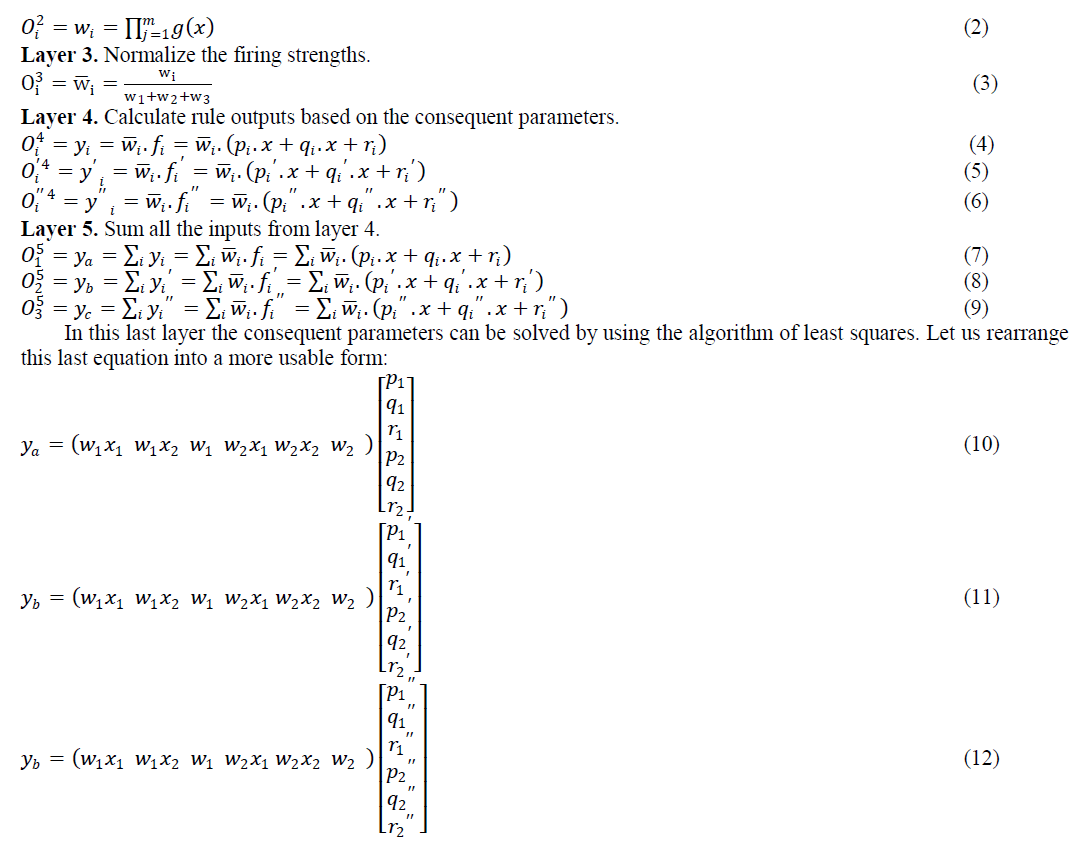 |
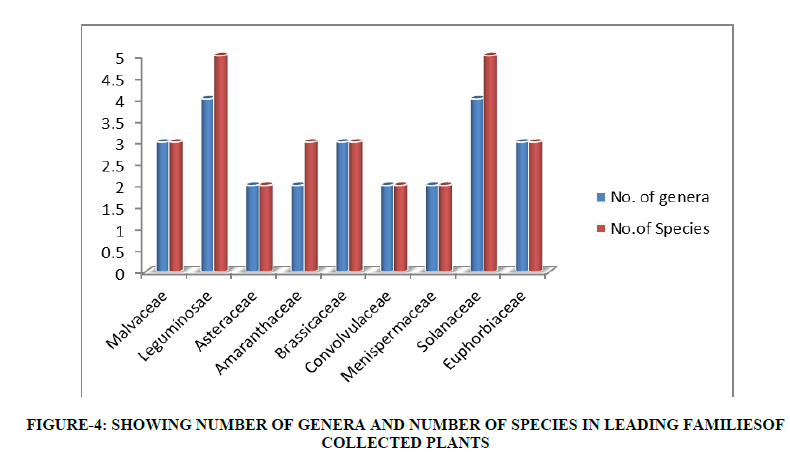 |
| Fig.1 M-ANFIS for one-input first-order Sugeno model with three rules - architecture with three outputs |
| The MANFIS for three outputs comprises an alone input, so, there are no therefore rules of inference for this system, but there exists a opérations of fuzzification and a défuzzification similar to that of ANFIS of one output (Heck et al. 2000). |
Operation of training |
| The M-ANFIS training paradigm uses a gradient descent algorithm to optimize the antecedent parameters, and a least squares algorithm to solve for the consequent parameters. The consequent parameters are updated first using a least squares algorithm, and the antecedent parameters are then updated by back-propagating the errors that still exist. |
The back-propagation of the gradient |
| In the stage of back-propagation, the signal of error is back propagated and local parameters are updated by the method of gradient descent. For the neuro-fuzzy system to an alone output y, we have: |
 |
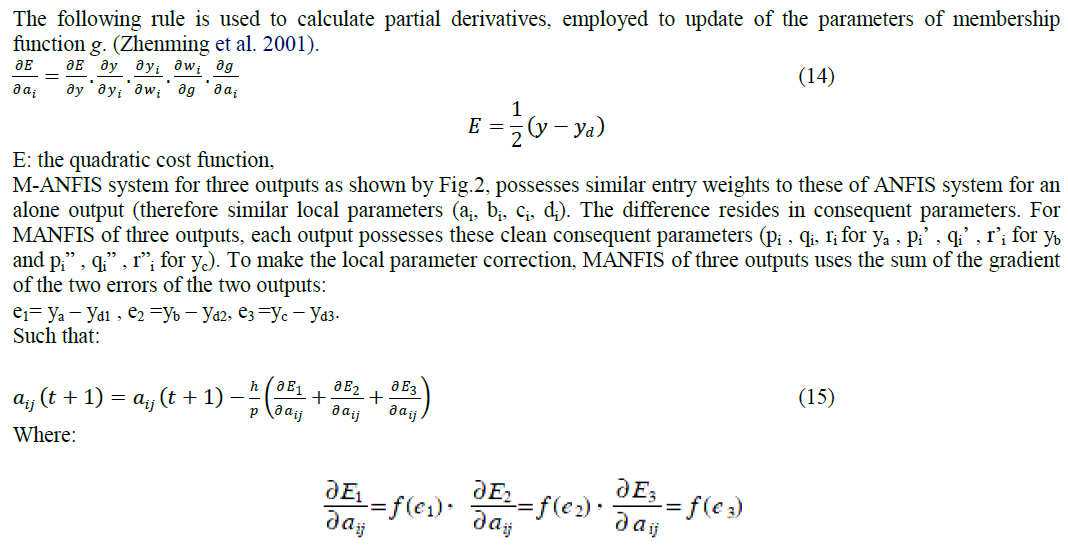 |
Measurement of experimental data |
| The experimental study was conducted on a Ford-MVH.416-ZETEC gasoline engine with a TWC. The engine is fourcylinder, four stroke engine with a swept volume of 1588 cc. The general specifications of the engine are shown in Table 1. The catalytic converter used is a two piece TWC of 0.749. Exhaust emission was measured by emission analyzer. Before the experiments the analyzer was calibrated. |
| The schematic view of the test equipments is shown in Fig.2. Temperatures were measured with temperature measuring system having 1 degree of Celsius accuracy. Thermocouples were used for temperature measurement. In the experimental study, catalytic converter temperature, HC and CO emission variations were measured during cold-start period of the engine with standard and burner heated catalytic converter, under idle operating conditions. Before the engine was started, the burner was activated to heat up the catalytic converter. The burner was located in front of the catalytic converter (Fig.2). Liquefied petroleum gas (LPG) was burned in the burner to heat the main catalyst faster. The preheat temperature of the catalyst was 200 0C. Data recording was commenced when the engine was started (0 s) and continued for 900 s. All the tests were performed for cold starts of the engine. Also, the engine was shut down for 12 h before the next test to provide an ambient temperature start. |
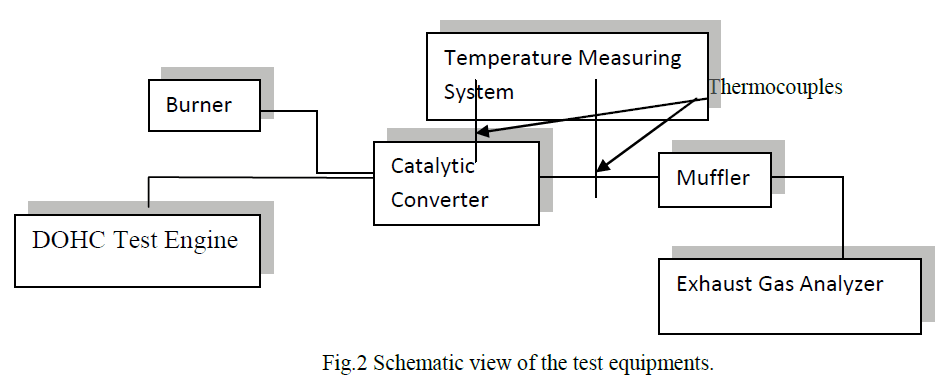 |
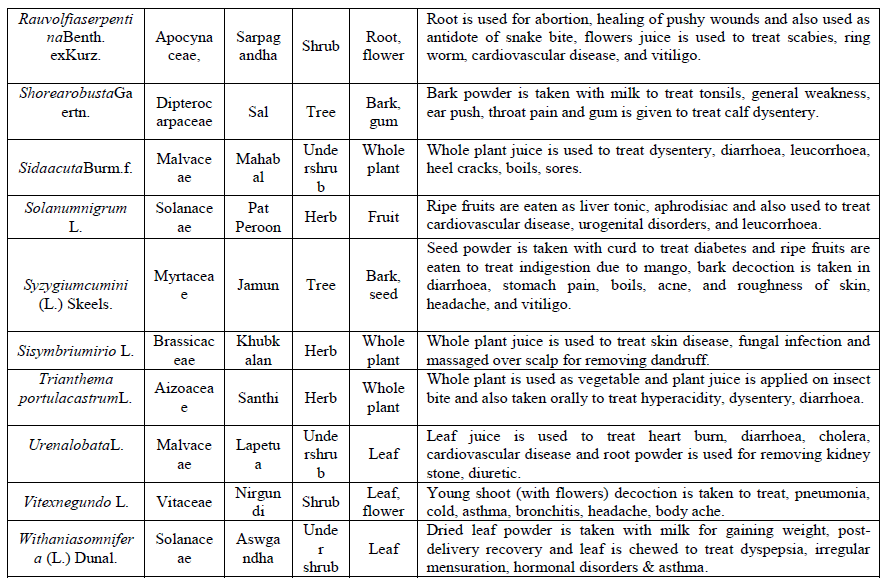 |
APPLICATION OF MULTIOUTPUT ANFIS SYSTEM FOR THREE OUTPUTS OF CATALYTIC CONVERTER STANDARD PARAMETERS AND HEATED PARAMETERS. |
| Multioutput ANFIS (MANFIS) proposed in Fig.3 is firstly implemented for standard parameters then it is implemented for heated parameters. Both the MANFISs, one for standard parameters called S-MANFIS and another for heated parameters called H-MANFIS are organized in as shown in Fig.3 below, to find the desired results simultaneously from the proposed MANFIS Model |
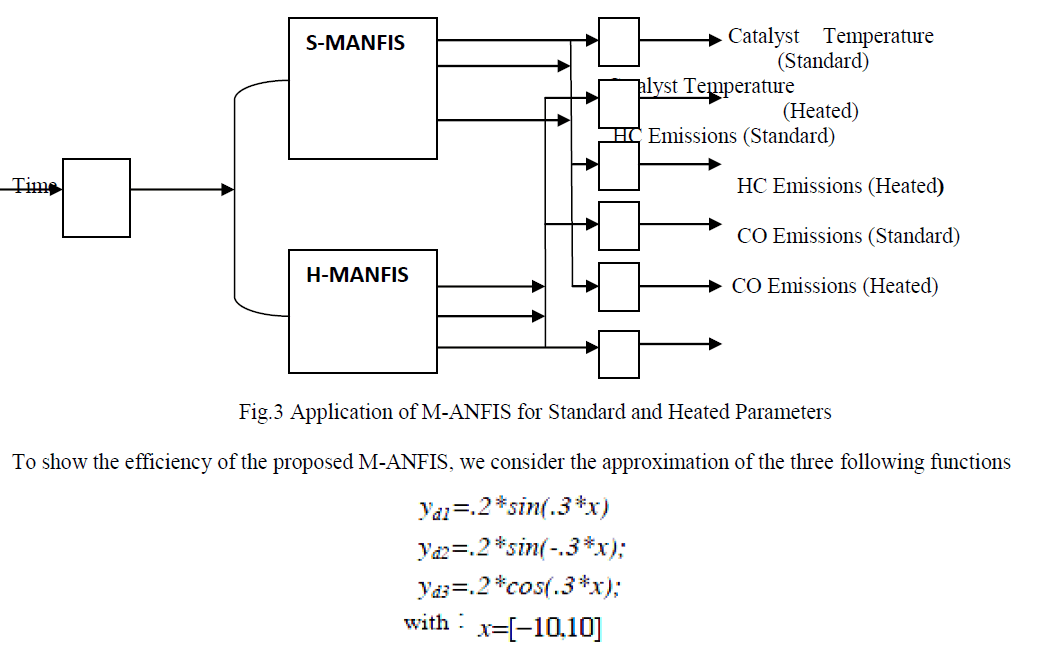 |
| The precision of M-ANFIS increases with the number of weight of inputs. For M-ANFIS of three outputs, it concerns three errors of estimation (for yd1, yd2 and yd3). To make the approximation of these three functions, we have used a MANFIS of three weights in the input (in first layer). Then, and so as to have best results of approximation, we have used a M-ANFIS with six weights in the input. Then we have made the comparison of the results of the approximation for the two M-ANFIS systems. Local parameters are initialed to small values that we have chosen to accelerate the convergence. The type of membership function of M-ANFIS that we have used is the trapezoidal function. |
VALIDATION OF PROPOSED MULTIOUTPUT ANFIS |
| To make the simulation of the M-ANFIS system, we have used Matlab 7.0 software. Next figures show results of the approximation of the three functions yd1 , yd2 , yd3 by the proposed M-ANFIS with three weighs in the input, and by MANFIS with six weighs in the input. |
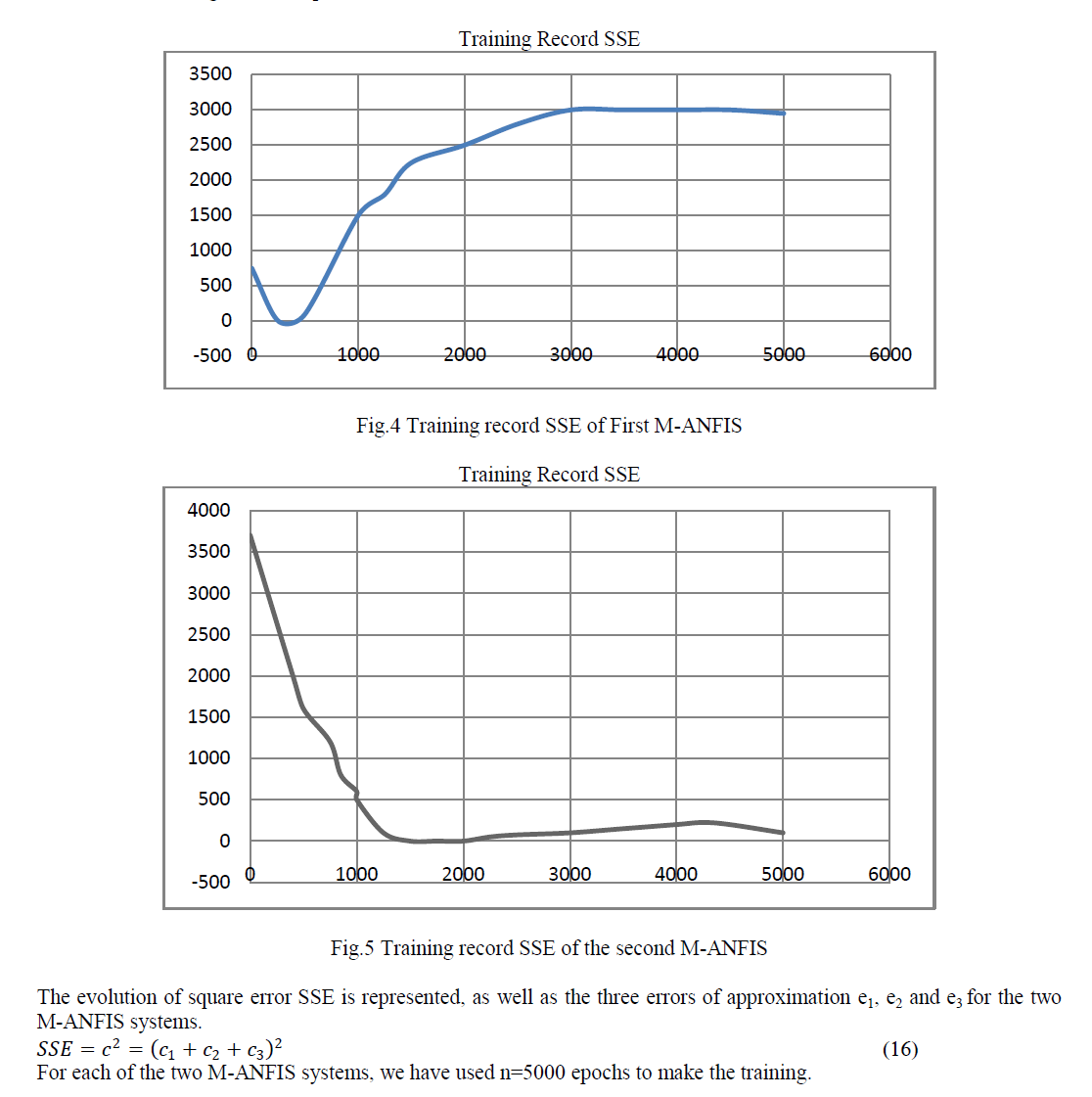 |
INTERPRETATION OF RESULTS |
| Results of figures show that the proposed multioutput adaptive neuro-fuzzy system, has allowed to approximate the three function yd1, yd2 and yd3 in same time temp with a great precision. Also, the increase of the number of weight to the entry of M-ANFIS system (three to six weights), allows improving precision of the approximation of the three desired functions simultaneously: - Errors of approximation (e1, e2 and e3) are smaller for M-ANFIS of six weight in the first layer that these of M-ANFIS of three weights in first layer. - The square error (SSE) pass of meadows of 10-3 for M-ANFIS of three weights to almost 2,7x10-3 for M-ANFIS of six weights. M-ANFIS of six weights in the first layer converges more rapidly than M-ANFIS of three weights. |
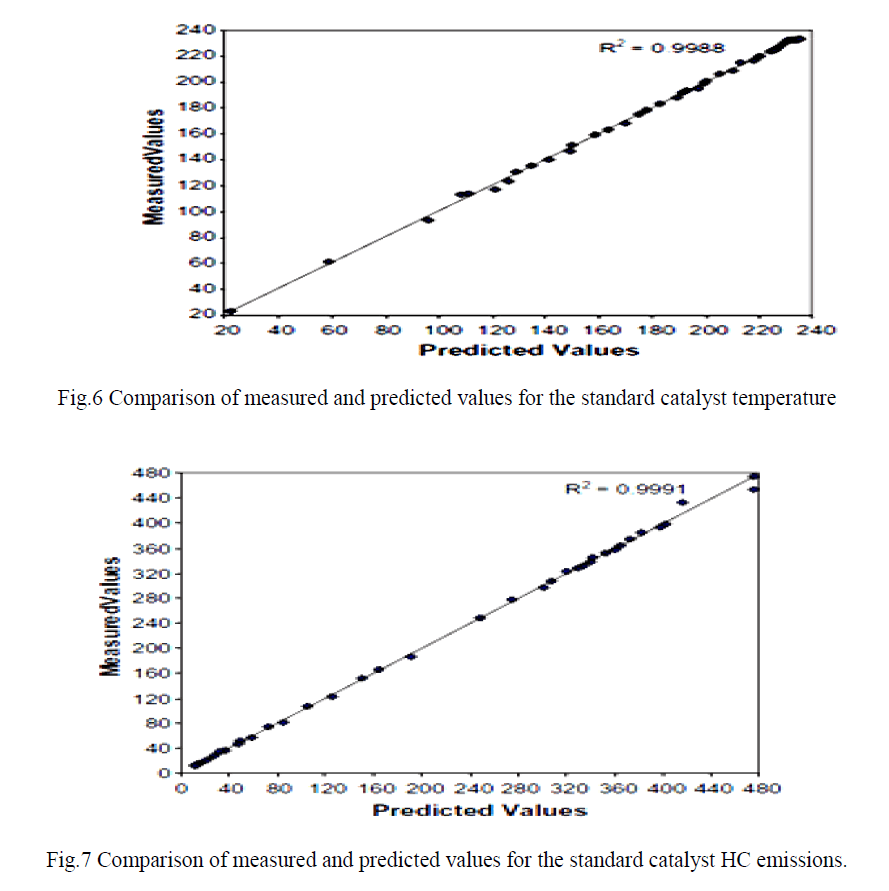 |
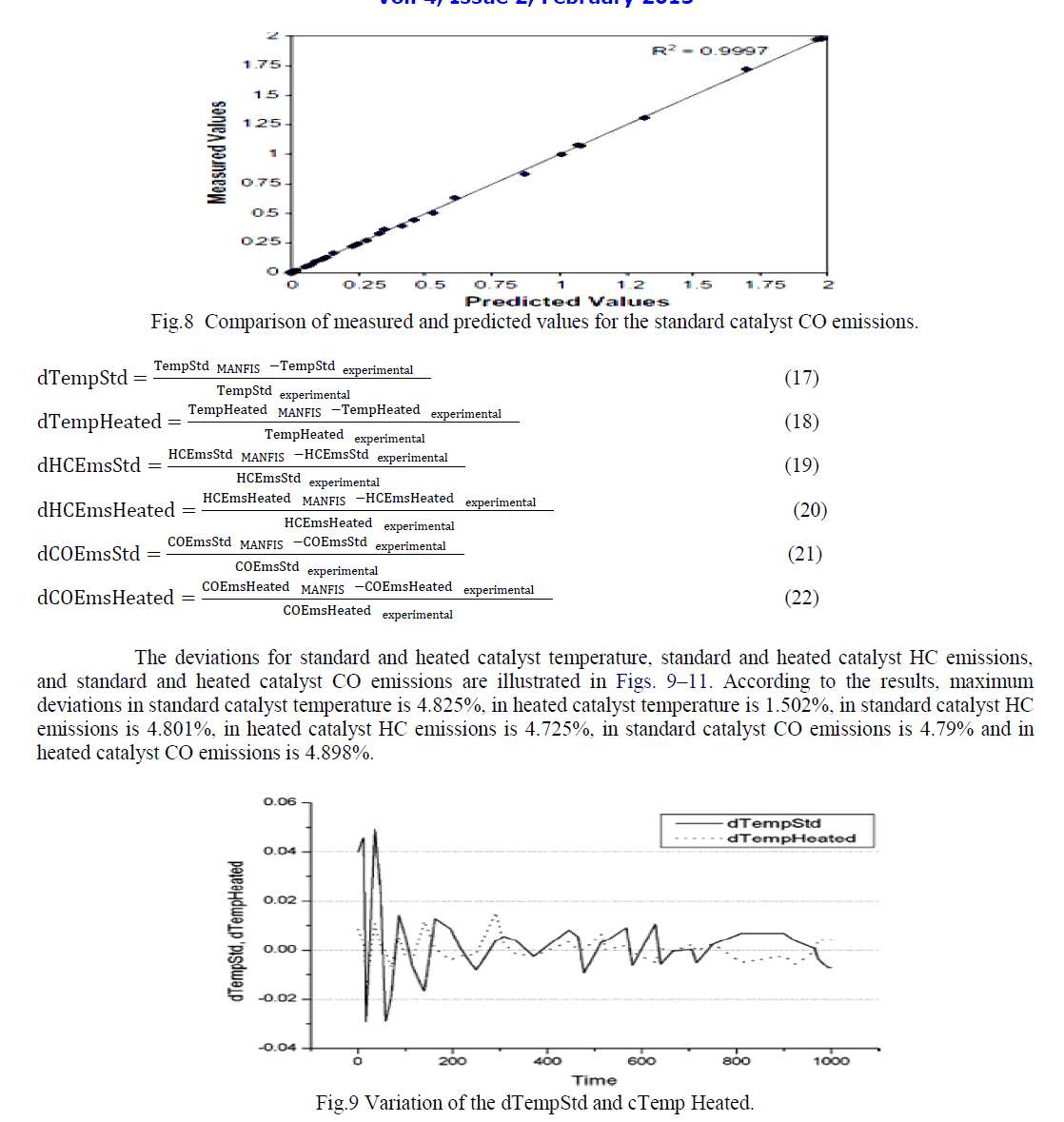 |
| Table 2 shows the minimum and maximum deviations for each of the output. These results be prove that the proposed M-ANFIS can be used successfully for the prediction of catalyst temperature, HC emissions and CO emissions for the system. |
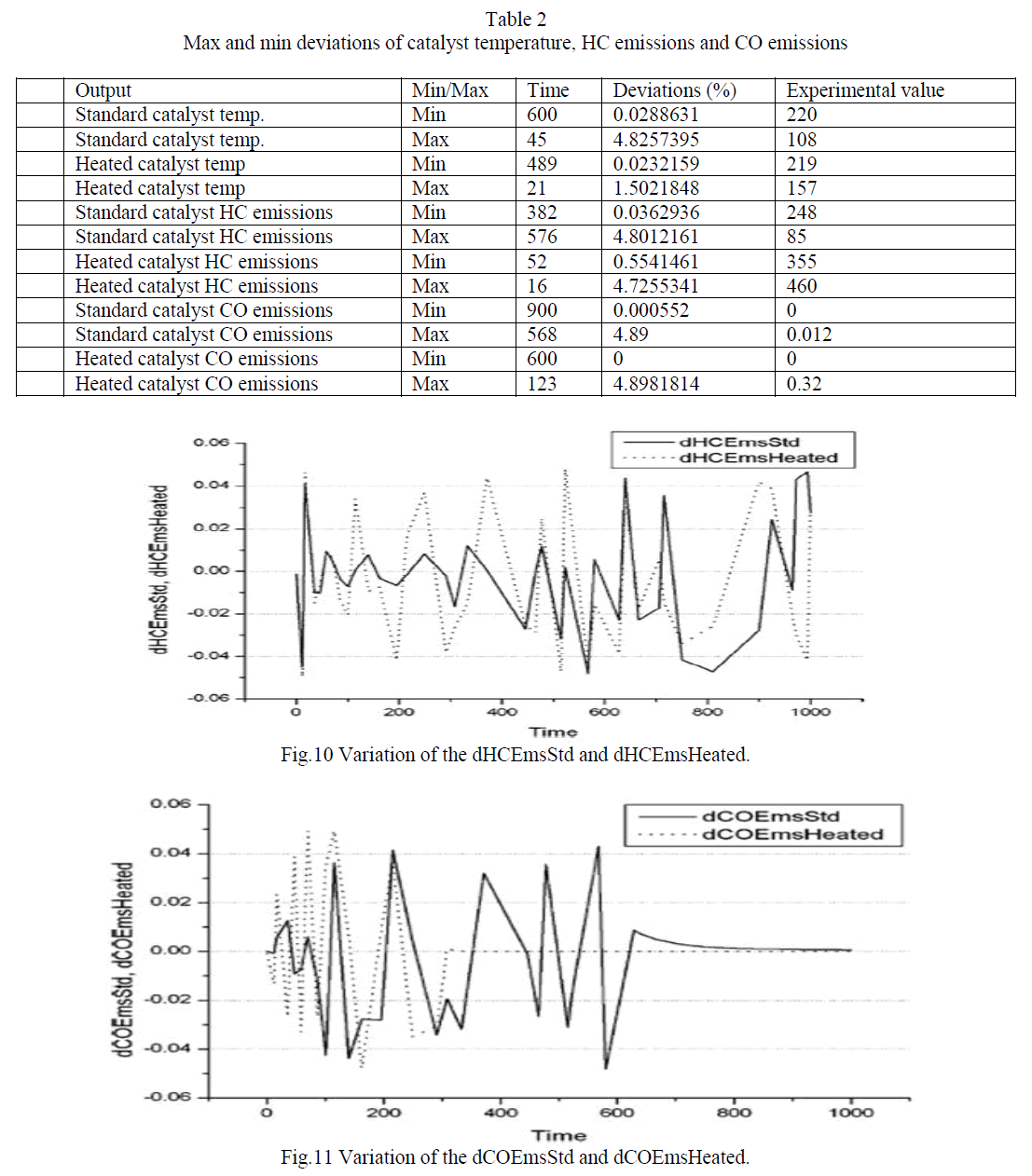 |
CONCLUSIONS |
| In this study, an artificial neural network is used for prediction of catalyst temperature, HC emissions and CO emissions in the catalytic converter. HC and CO emission variations were measured during cold-start period of the engine with standard and burner heated catalytic converter under idle operating conditions engine speed. Before the engine was started, the burner was activated to heat up the catalytic converter. LPG is burned in the burner to heat the main catalyst faster. The preheat temperature of the catalyst was 200 0C. Data recording was commenced when the engine was started (0 s) and continued for 900 s. All the tests were performed for cold starts of the engine. Also, the engine was shut down for 12 h before the next test to provide an ambient temperature start. |
| The deviations for catalyst temperature, HC emissions and CO emissions for different time are obtained by using MANFIS. The maximum deviations are 4.825% for standard catalyst temperature, 1.502% for heated catalyst temperature, 4.801% for standard catalyst HC emissions, 4.725% for heated catalyst HC emissions, 4.79% for standard catalyst CO emissions, and 4.898% for heated catalyst CO emissions. The statistical coefficients are above 0.99. This degree of accuracy shows that the proposed M-ANFIS can be used to obtain the experimental data. To sum up, this study is considered to be helpful in predicting the performance of the catalytic converter. |
| Proposed Multi-output Adaptive neuro-fuzzy system has given good results of approximation of the two different functions yd1 , yd2 and yd3. The increase of the number of weight of the multioutput neuro-fuzzy system allows improving the precision of approximation: |
| 1. The Square of the sum of the two errors of approximation of the two functions is decreased approximately of 4 times. |
| 2. The values of the three errors of approximation of the three functions yd1, yd2 and yd3 have also decreased. From that, we can say that the proposed multi output adaptive neuro-fuzzy system can approximates functions with good precision and good rapidity. |
References |
|